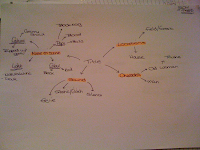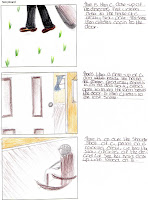Saturday, 27 February 2010
Thriller Task- Filming 26/02/10
Monday, 22 February 2010
Main Task 22/02/10
Thriller Task-Planning

![[USE.JPG]](https://blogger.googleusercontent.com/img/b/R29vZ2xl/AVvXsEhq6mqm3nmWLHJuFEK-9Bz7-vjjNHui6DDmG5JXYMXaGnvr7M-CgnHC2EhXdBOmjH6yTLmbM1pQnom1SefrScJJOXSoHEhEvokDb1Uj5keXi8bh_kSaBx9OcyIMMVfvo22KvO8gE7cx4JmP/s1600/USE.JPG)
This is the mind map that myself and the rest of the group created to put all of our ideas together so that we could start producing our clip. This one was the first draft.
 This is the second part of the storyboard that we made after planning our rough draft.
This is the second part of the storyboard that we made after planning our rough draft.This is the first part of the storyboard that we made after finishing our rough draft.
Thriller Task- Planning
In our footage we are using a minimal amount of props so that our clip gains a more mysterious effect. We have decided that we are only going to use three props. They are;
A shawl (For Natasha's character)
A plastic black bag (For my character when he is dragging it across the floor. We are going to put a heavy object inside so that makes it look more realistic.)
A rocking chair (For Natasha's charater when we see her rocking back and forth.)
Thriller Research
Thriller is a broad genre of literature, film and television that includes numerous and often overlapping sub-genres Thrillers are characterized by fast pacing, frequent action, and resourceful heroes who must thwart the plans of more powerful and better equipped villains. Writer Vladimir Nabokov, in his lectures at Cornell University, said that "In an Anglo-Saxon thriller, the villain is generally punished, and the strong silent man generally wins the weak babbling girl, but there is no governmental law in Western countries to ban a story that does not comply with a fond tradition, so that we always hope that the wicked but romantic fellow will escape scot-free and the good but dull chap will be finally snubbed by the moody heroine.
Characteristics
Thrillers often take place wholly or partly in exotic settings such as foreign cities, deserts, polar regions, or high seas. The heroes in most thrillers are frequently "hard men" accustomed to danger: law enforcement officers, spies, soldiers, seamen or aviators. However, they may also be ordinary citizens drawn into danger by accident. While such heroes have traditionally been men, women lead characters have become increasingly common; for an early example see Sigourney Weaver's character Ripley, in the movie Alien, 1979.
Thrillers often overlap with mystery stories, but are distinguished by the structure of their plots. In a thriller, the hero must thwart the plans of an enemy, rather than uncover a crime that has already happened; while a murder mystery would be spoiled by a premature disclosure of the murderer's identity, in a thriller the identity of a murderer or other villain is typically known all along. Thrillers also occur on a much grander scale: the crimes that must be prevented are serial or mass murder, terrorism, assassination, or the overthrow of governments.
Examples of thriller types
• Action thriller: In which the work often features a race against the clock, contains lots of violence, and an obvious antagonist. These films usually contain large amounts of guns, explosions, and large elaborate set pieces for the action to take place. These films often have elements of mystery films and crime films but these elements take a backseat to action. Notable examples are the James Bond films, The Transporter, and the Jason Bourne novels and films.
• Conspiracy thriller: In which the hero/heroine confronts a large, powerful group of enemies whose true extent only he/she recognizes. The Chancellor Manuscript and The Aquitane Progression by Robert Ludlum fall into this category, as do films such as Three Days of the Condor, Capricorn One, and JFK.
• Crime thriller: This particular genre is a hybrid type of both crime films and thrillers that offers a suspenseful account of a successful or failed crime or crimes. These films often focus on the criminal(s) rather than a policeman. Crime thrillers usually emphasize action over psychological aspects. Central topics of these films include murders, robberies, chases, shootouts, and double-crosses are central ingredients. Some examples include The Killing, Seven, Reservoir Dogs, Inside Man, and The Asphalt Jungle.
• Disaster thriller: In which the main conflict is due to some sort of natural or artificial disaster, such as floods, earthquakes, hurricanes, volcanoes, etc., or nuclear disasters as an artificial disaster. Examples include Stormy Weather by Carl Hiaasen, Tremor by Winston Graham, and the 1974 film Earthquake.
• Drama thriller: In which the story consists of the elements of a thriller and drama film. These films are usually slower paced and involve a great deal of character development along with plot twists. Examples include The Illusionist, The Interpreter and The Prestige.
• Science-fiction thriller: Alien and Kim Stanley Robinson's Mars Trilogy and Ian Irvine's Human Rites Trilogy and Dasavathaaram are examples of science-fiction thrillers.
• Horror thriller: In which the main character is put in danger and their main enemies are unrealistic creatures in which they must destroy to achieve their goal. Films such as Evil Dead 2 and Zombie 2 fit into this genre of thriller.
• Erotic thriller: In which it consists of erotica and thriller. It has become popular since the 1980s and the rise of VCR market penetration. The genre includes such films as Basic Instinct, Dressed to Kill, Color of Night, Eyes Wide Shut, Fatal Attraction, Looking for Mr. Goodbar, Obsessed, and In the Cut.
( The source where I gathered all of my research was from wikipeida: http://en.wikipedia.org/wiki/Thriller_(genre )
Thriller Task- Planning
| To reduce the risk of injury, all people involved should be careful when walking, especially when walking with heavy equipment and around areas with uneven ground and fallen debris. | |
Drowning | Cast members and crew should take extra precaution when filming next to the river to avoid situations such as falling in. | |
Damage to equipment | All participants must take extra care when handling filming equipment so that no damage takes place. | |
Illness | If a member of the cast or crew falls ill and is unable to attend an arranged date, a replacement should be considered or a new date should be proposed. | |
Weather conditions | If the weather is unsuitable at the proposed date of filming, indoor scenes should be filmed instead and conditions should be coped with as best as possible. Crew should make sure no filming equipment is damaged due to weather. | |
Assault | If any scenes should be filmed at night, crew and cast must take safety measures in order to stay as safe as possible when filming outside to reduce the risk of an unwanted event taking place. |
Sunday, 21 February 2010
Thriller Task - Planning
Natasha Hoskins
Natasha will be playing the role of the mysterious woman found at the end of the clip rocking back and forth in a rocking chair. She is shrouded in a shawl and only her hands and eye are visible to the audience. We chose Natasha because she was an available actress who also lives close to our chosen filming locations.
Shaun Cutts
 Shaun will be playing the role of the hooded character in our footage. He will be wearing a black jumper and his hood will remain up throughout all the scenes he appears in so that his face is not visible at any point during the clip. We chose to use Shaun for this role because he has some acting experience and is also available for recording when we need to film because he is a member of our group.
Shaun will be playing the role of the hooded character in our footage. He will be wearing a black jumper and his hood will remain up throughout all the scenes he appears in so that his face is not visible at any point during the clip. We chose to use Shaun for this role because he has some acting experience and is also available for recording when we need to film because he is a member of our group.Questionnaire
| Do you prefer thrillers to be fast or slow paced? | 7 | 3 |
| Would you prefer minimal dialogue, or a substantial amount of dialogue? | 7 | 3 |
| Do you enjoy suspense or surprise? | 6 | 4 |
| Would a thriller be better with a few key characters, or a large cast? | 10 | 0 |
| Do you prefer dark environments, or lighter ones? (shot at night or in the daytime) | 5 | 5 |
| Do you prefer action-based thrillers or horror-based thrillers? | 8 | 2 |
| Would you prefer it to be shot realistically (as if you’re there) or abstract? | 9 | 1 |
| Would you prefer a soundtrack? | | |
| If YES, would you like a subtle or climatic soundtrack? | 3 | 5 |
| Would you prefer our characters’ identities to be hidden or clearly obvious from the beginning? | 10 | 0 |
| Would you prefer opening credits or not? | 10 | 0 |
| If YES, would you prefer them to roll quickly or slow to build tension? | 2 | 8 |
| Which font would you prefer? | FONT FONT FONT FONT | 1 2 6 |
| Where would you prefer it to be set? | Forest 1 House 0 | Lake/riverside 7 Attic 2 |
This is the questionnaire that myself and the rest of the group created in order to get a further insight of our target audiences opinions and preferences of thriller films.



Thriller Task- Questionnaire Results and Tables
 Our questionnaire showed us that our target audience prefer their thrillers to be fast paced rather than slow paced. This is most likely because fast paced thrillers are a lot more exciting than slow paced because of the tension and excitement that can be created through fast paced action or drama.
Our questionnaire showed us that our target audience prefer their thrillers to be fast paced rather than slow paced. This is most likely because fast paced thrillers are a lot more exciting than slow paced because of the tension and excitement that can be created through fast paced action or drama. Most of the people that we asked said that they would prefer our film to have a minimal amount of dialogue rather than a substantial amount. This is most likely because when hardly any dialogue is being used in a thriller, it creates a sense of wonder which eventually builds tension and suspense.
Most of the people that we asked said that they would prefer our film to have a minimal amount of dialogue rather than a substantial amount. This is most likely because when hardly any dialogue is being used in a thriller, it creates a sense of wonder which eventually builds tension and suspense.
Most of our target audience said that they prefer suspense over surprise, however taking this into thought suspense eventually tends to lead to surprise anyway. We will take this thought into account when creating our thriller so that our clip is mainly based around suspense rather than surprise.
 Rather than having a large cast of characters, our target audience all agreed to having a small number of key characters. This is so that the film is more focused on the storyline of the main characters and so that the audience don't lose interest.
Rather than having a large cast of characters, our target audience all agreed to having a small number of key characters. This is so that the film is more focused on the storyline of the main characters and so that the audience don't lose interest. The questionnaire showed us that 5 people preferred thrillers to be filmed at night, whilst the other 5 preferred thrillers to be filmed in the day. However, taking into account the safety of our actors, crew and equipment the more sensible option would be filming in the day rather than night to avoid any incidents or dangers.
The questionnaire showed us that 5 people preferred thrillers to be filmed at night, whilst the other 5 preferred thrillers to be filmed in the day. However, taking into account the safety of our actors, crew and equipment the more sensible option would be filming in the day rather than night to avoid any incidents or dangers. Our target audience showed that they would prefer an action-based thriller to a horror-based thriller. This is most likely because they prefer fast paced thrillers to slow paced as well. However myself and the rest of the group should make sure that the thriller is not too fast paced for the audience so that there isn't enough time for a decent storyline to be created.
Our target audience showed that they would prefer an action-based thriller to a horror-based thriller. This is most likely because they prefer fast paced thrillers to slow paced as well. However myself and the rest of the group should make sure that the thriller is not too fast paced for the audience so that there isn't enough time for a decent storyline to be created. The majority of the people we asked said that they would prefer our thriller to be shot realistically (realistically meaning 'as if you were there') rather than abstract. This is most likely because our audience prefer to have situations that they can imagine themselves in so that they understand the storyline or characters better.
The majority of the people we asked said that they would prefer our thriller to be shot realistically (realistically meaning 'as if you were there') rather than abstract. This is most likely because our audience prefer to have situations that they can imagine themselves in so that they understand the storyline or characters better. About 80% of the people we asked said that they would prefer our thriller to have a soundtrack with music and dialogue.
About 80% of the people we asked said that they would prefer our thriller to have a soundtrack with music and dialogue. This question showed us that our target audience would prefer our thriller to have a dramatic and climatic soundtrack in oppose to a normal subtle soundtrack. This is most likely because the subtle soundtrack could not build up as much tension as a climatic soundtrack could.
This question showed us that our target audience would prefer our thriller to have a dramatic and climatic soundtrack in oppose to a normal subtle soundtrack. This is most likely because the subtle soundtrack could not build up as much tension as a climatic soundtrack could. Our target audience said that they would prefer our characters identities to be hidden in our film rather than blatantly exposed at the very beginning. This is most likely because they would prefer our characters identities to remain hidden so that there is an air of suspicion around them.
Our target audience said that they would prefer our characters identities to be hidden in our film rather than blatantly exposed at the very beginning. This is most likely because they would prefer our characters identities to remain hidden so that there is an air of suspicion around them. Everyone who was asked said that they would prefer to have opening credits at the beginning of the film. Most likely because this would give the film a more serious and realistic appearance.
Everyone who was asked said that they would prefer to have opening credits at the beginning of the film. Most likely because this would give the film a more serious and realistic appearance. Most of everyone who we asked said that they would prefer the credits to role slowly rather than quickly. Presumably, this is so that they will have enough time to read them and also because it will add to the dramatic effect of the thriller.
Most of everyone who we asked said that they would prefer the credits to role slowly rather than quickly. Presumably, this is so that they will have enough time to read them and also because it will add to the dramatic effect of the thriller. From the questionnaire we can see that the Rage Italic font was the most popular out of the selection of fonts we considered using for the opening credits. However it seems that this font is slightly difficult to read which could cause problems later on during editing, therefore this font may have to be reconsidered.
From the questionnaire we can see that the Rage Italic font was the most popular out of the selection of fonts we considered using for the opening credits. However it seems that this font is slightly difficult to read which could cause problems later on during editing, therefore this font may have to be reconsidered. The most popular choice for this question was the River/Lakeside option. However we may have to reconsider this due to the time limits and our group members availabilities.
The most popular choice for this question was the River/Lakeside option. However we may have to reconsider this due to the time limits and our group members availabilities.





